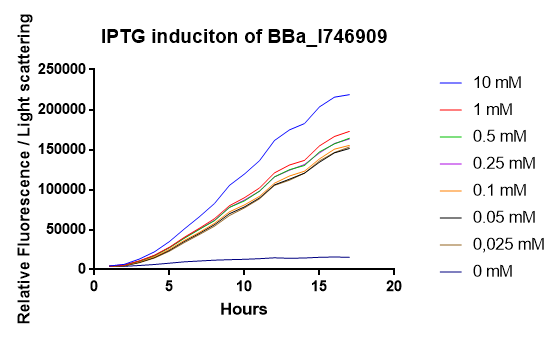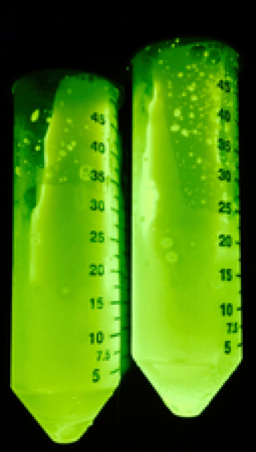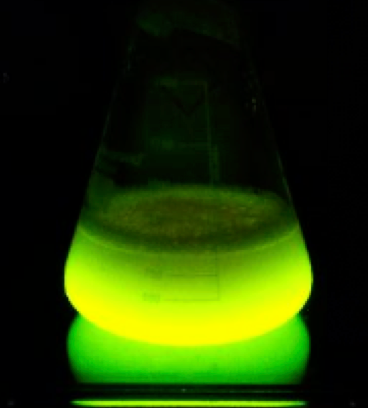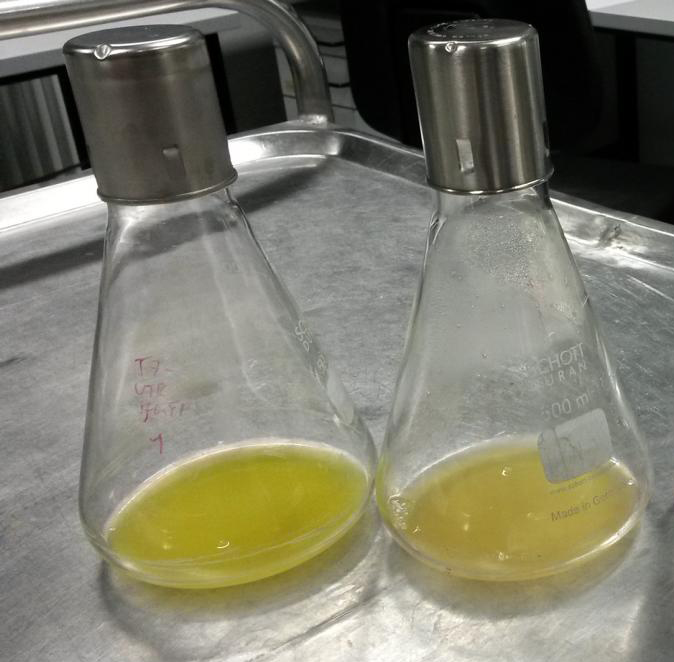Difference between revisions of "Part:BBa I746909:Experience"
(→Applications of BBa_I746909) |
|||
| (39 intermediate revisions by 7 users not shown) | |||
| Line 4: | Line 4: | ||
===Applications of BBa_I746909=== | ===Applications of BBa_I746909=== | ||
| + | |||
| + | <html> | ||
| + | <h2> 2021 Lambert_GA iGEM Team </h2> | ||
| + | |||
| + | <p> <a href="https://2021.igem.org/Team:Lambert_GA">2021 Lambert_GA iGEM Team</a> validated this part in our cell-free lysates of BL21 (DE3).<br><br></p> | ||
| + | |||
| + | </html> | ||
| + | Lambert_GA iGEM 2021 developed cell-free lysates from E.coli BL21(DE3) competent cells. These lysates were then tested with BBa_I746909 and IPTG induction. Fluorescence was measured three hours after incubating lysate, plasmid BBa_I746909, and master mix at 37ºC. Excitation was measured at 485 nm and emission at 510 nm. The lysate and plasmid BBa_I746909 were tested without IPTG induction and 10mM IPTG. The graph below shows sfGFP expression for our samples. | ||
| + | |||
| + | [[File:CellFreesfGFPExpression.png|thumb|center|500px|<i>Figure 2. The table above shows the cell-free sfGFP expression of blank, lysate+BBa_I746909, and lysate+BBa_I746909+IPTG.</i>]] | ||
| + | |||
| + | |||
| + | This validates this part because the T7 RNAP naturally found in the E. coli BL21 strain is able to express the T7 driven sfGFP, and additional IPTG results in additional expression. This also verifies the efficacy of our cell-free lysates. | ||
<html> | <html> | ||
| − | <h2> | + | <h2>2019 iGEM team Gunma Japan</h2> |
| − | <p> <a href=" | + | <p> <a href="https://2019.igem.org/Team:Gunma">2019 iGEM team Gunma Japan</a>validated this part in BL21(DE3).<br><br></p> |
</html> | </html> | ||
| − | |||
| + | We moved our data from here to the main page! | ||
| + | Please check : https://parts.igem.org/Part:BBa_I746909 | ||
| − | + | Gunma | |
| + | <html> | ||
| + | <h2> 2018 iGEM team Linkoping Sweden </h2> | ||
| − | + | <p> <a href="http://2018.igem.org/Team:Linkoping_Sweden">2018 iGEM team Linkoping Sweden</a> validated this part.<br><br></p> | |
| + | </html> | ||
| + | The IPTG induction of BBa_I746909 was validated by expressing the protein in E. coli (BL21). Fluorescence was measured over 16 hours after IPTG induction and the bacteria was incubated at 37°C. Excitation was measured at 488 nm and emission at 510 nm. The optical density was measured at 600 nm. Different induction concentration of IPTG was used to stimulate the expression. Experiments were conducted in an infinite M1000 PRO plate reader. Graphs show the mean values of fluorescents per bacteria of 6 replicates. The error bars for Figure 2. represent the 95 % confidence interval. Results seem to indicate that 10 mM IPTG will give the most effective induction response and that the IPTG promoter is very sensitive. We make this statement from the fact that our smallest induction concentration (0,025mM) induced almost the same amount of fluorescence as our next strongest induction concentration (1mM). | ||
| + | [[File:T--Linkoping_Sweden--iptginductionparts.png|thumb|600px|center| Figure 1: The figure shows IPTG stimulation of the biobrick BBa_I746909 over 16 hours, the mesurments was carried out in a 96 well M1000 Pro plate reader at 37°C. Fluorescence was exited at 488 nm and emission was measured at 510 nm . Light scattering were excited at 600 nm.]] | ||
| + | [[File:T--Linkoping_Sweden--stapeliptg.png|thumb|600px|center| Figure 2: The figure shows the end results after a 16 hour IPTG induction of BBa_I746909 at 37°C. The induction was carried out in a M1000 Pro plate reader. Fluorescence was excited at 488 nm and emission was measured at 510 nm . Light scattering was excited at 600 nm. The error bars represent a 95% confidence interval.]] | ||
| Line 65: | Line 85: | ||
|- | |- | ||
|'''{{{title|Testing I746909 in WatsOn}}}'''<br />{{{subtitle|I746909 in sensor chips induced with 2µl IPTG and measured with WatsOn. Left chip is not induced, right chip is induced with IPTG. }}} | |'''{{{title|Testing I746909 in WatsOn}}}'''<br />{{{subtitle|I746909 in sensor chips induced with 2µl IPTG and measured with WatsOn. Left chip is not induced, right chip is induced with IPTG. }}} | ||
| + | |} | ||
| + | </diV> | ||
| + | </center> | ||
| + | <html> | ||
| + | <h2> 2015 iGEM team Bielefeld-CeBiTec </h2> | ||
| + | |||
| + | <p> <a href="http://2015.igem.org/Team:Bielefeld-CeBiTec">2015 iGEM team Bielefeld-CeBiTec</a> used this part and improved it by addition of a designed, translation enhancing 5'-untranslated region (5'-UTR; <a href="https://parts.igem.org/Part:BBa_K1758100">BBa_K1758100</a>). You can find further information at <a href="https://parts.igem.org/Part:BBa_K1758102">BBa_K1758102</a>). </p> </html> | ||
| + | |||
| + | |||
| + | [[File:Bielefeld-CeBiTec_CFPS_UTR.png|thumb|600px|center|In vivo characterization of sfGFP with and without our designed, translation enhancing 5'-untranslated region (5'-UTR; BBa_K1758100). Relative fluorescence units were normalized on OD600. Error bars represent standard deviation of triplicates. PT7-sfGFP: BBa_I746909 (this part); PT7-UTR-sfGFP: BBa_K1758102]] | ||
| + | |||
| + | |||
| + | As can be seen in the picture, the difference was observable with the naked eye as well. | ||
| + | |||
| + | |||
| + | [[File:Bielefeld-CeBiTec_CFPS_UTR_cultures.png|thumb|400px|center|Comparision of cultures expressing sfGFP with the optimized UTR and without. Left: BBa_K1758102, right: BBa_I746909 (this part)]] | ||
| + | |||
| + | |||
| + | |||
| + | |||
| + | ====[http://2014.igem.org/Team:Imperial iGEM Team Imperial==== | ||
| + | |||
| + | <center> | ||
| + | <div class="figure" style="float:{{{align|center}}}; margin: 0px 10px 10px 40px; border:{{{border|0px solid #aaa}}};width:{{{width|480px}}};padding:10px 10px 0px 0px;"> | ||
| + | {| | ||
| + | |||
| + | [[File:IC-2014_glow1.jpg |200px|left|]] | ||
| + | |||
| + | [[File:IC-2014_glow2.jpg |400px|lright|]] | ||
| + | |||
| + | We used this part as a template to make our own part (K1321337). We added Freiburg sites onto the existing sfGFP using overhang end primers during PCR. The part we made was sequence confirmed and showed very bright fluorescence, even when fused to our CBDs (cellulose binding domains). | ||
| + | |||
|} | |} | ||
</div> | </div> | ||
| Line 73: | Line 125: | ||
| + | ====[http://2014.igem.org/Team:Aachen iGEM Team Aachen==== | ||
| + | The iGEM Team Aachen used the biobrick I746909 to test their [http://2014.igem.org/Team:Aachen/Project/2D_Biosensor sensor chip technology]. | ||
| + | <center> | ||
| + | <div class="figure" style="float:{{{align|center}}}; margin: 0px 10px 10px 40px; border:{{{border|0px solid #aaa}}};width:{{{width|480px}}};padding:10px 10px 0px 0px;"> | ||
| + | {| | ||
| + | |<html> <img src="https://static.igem.org/mediawiki/parts/d/d3/Aachen_I746909_slower_all.gif" width="480px"></html> | ||
| + | |- | ||
| + | |'''{{{title|Testing I746909 in sensor chips}}}'''<br />{{{subtitle|I746909 in sensor chips induced with 2µl IPTG and measured with a plate reader. Top chip is not induced, bottom chip is induced with IPTG. }}} | ||
| + | |} | ||
| + | </div> | ||
| + | </center> | ||
| + | |||
| + | The biorbick I746909 was also used to test the measurement device [http://2014.igem.org/Team:Aachen/Project/Measurement_Device WatsOn]. | ||
| + | |||
| + | <center> | ||
| + | <div class="figure" style="float:{{{align|center}}}; margin: 0px 10px 10px 40px; border:{{{border|0px solid #aaa}}};width:{{{width|480px}}};padding:10px 10px 0px 0px;"> | ||
| + | {| | ||
| + | |<html> <img src="https://static.igem.org/mediawiki/parts/b/b6/Aachen_I746909_slower_reduced.gif" width="480px"></html> | ||
| + | |- | ||
| + | |'''{{{title|Testing I746909 in WatsOn}}}'''<br />{{{subtitle|I746909 in sensor chips induced with 2µl IPTG and measured with WatsOn. Left chip is not induced, right chip is induced with IPTG. }}} | ||
| + | |} | ||
| + | |||
| + | </div> | ||
| + | </center> | ||
===User Reviews=== | ===User Reviews=== | ||
Latest revision as of 17:49, 20 October 2021
This experience page is provided so that any user may enter their experience using this part.
Please enter
how you used this part and how it worked out.
Applications of BBa_I746909
2021 Lambert_GA iGEM Team
2021 Lambert_GA iGEM Team validated this part in our cell-free lysates of BL21 (DE3).
This validates this part because the T7 RNAP naturally found in the E. coli BL21 strain is able to express the T7 driven sfGFP, and additional IPTG results in additional expression. This also verifies the efficacy of our cell-free lysates.
2019 iGEM team Gunma Japan
2019 iGEM team Gunma Japanvalidated this part in BL21(DE3).
We moved our data from here to the main page! Please check : https://parts.igem.org/Part:BBa_I746909
Gunma
2018 iGEM team Linkoping Sweden
2018 iGEM team Linkoping Sweden validated this part.
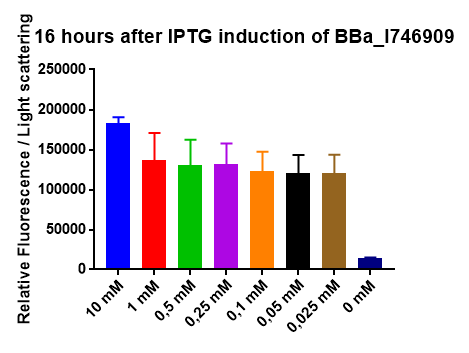
[http://2014.igem.org/Team:Imperial iGEM Team Imperial
[http://2014.igem.org/Team:Aachen iGEM Team Aachen
The iGEM Team Aachen used the biobrick I746909 to test their [http://2014.igem.org/Team:Aachen/Project/2D_Biosensor sensor chip technology].

|
| Testing I746909 in sensor chips I746909 in sensor chips induced with 2µl IPTG and measured with a plate reader. Top chip is not induced, bottom chip is induced with IPTG. |
The biorbick I746909 was also used to test the measurement device [http://2014.igem.org/Team:Aachen/Project/Measurement_Device WatsOn].

|
| Testing I746909 in WatsOn I746909 in sensor chips induced with 2µl IPTG and measured with WatsOn. Left chip is not induced, right chip is induced with IPTG. |
2015 iGEM team Bielefeld-CeBiTec
2015 iGEM team Bielefeld-CeBiTec used this part and improved it by addition of a designed, translation enhancing 5'-untranslated region (5'-UTR; BBa_K1758100). You can find further information at BBa_K1758102).
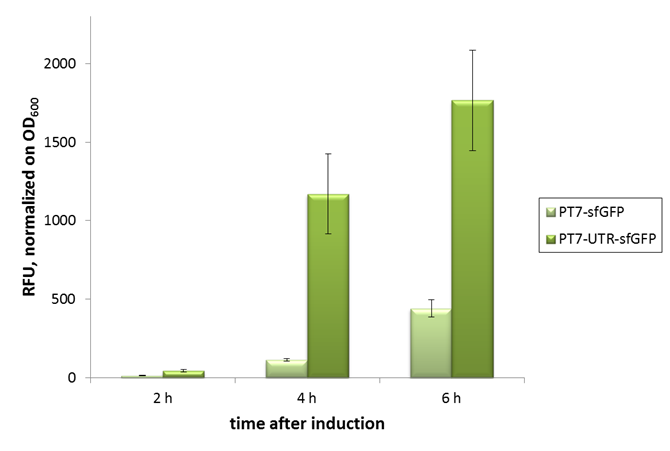
As can be seen in the picture, the difference was observable with the naked eye as well.
[http://2014.igem.org/Team:Imperial iGEM Team Imperial
[http://2014.igem.org/Team:Aachen iGEM Team Aachen
The iGEM Team Aachen used the biobrick I746909 to test their [http://2014.igem.org/Team:Aachen/Project/2D_Biosensor sensor chip technology].

|
| Testing I746909 in sensor chips I746909 in sensor chips induced with 2µl IPTG and measured with a plate reader. Top chip is not induced, bottom chip is induced with IPTG. |
The biorbick I746909 was also used to test the measurement device [http://2014.igem.org/Team:Aachen/Project/Measurement_Device WatsOn].

|
| Testing I746909 in WatsOn I746909 in sensor chips induced with 2µl IPTG and measured with WatsOn. Left chip is not induced, right chip is induced with IPTG. |
User Reviews
UNIQb3949fee8a520802-partinfo-00000008-QINU UNIQb3949fee8a520802-partinfo-00000009-QINU


